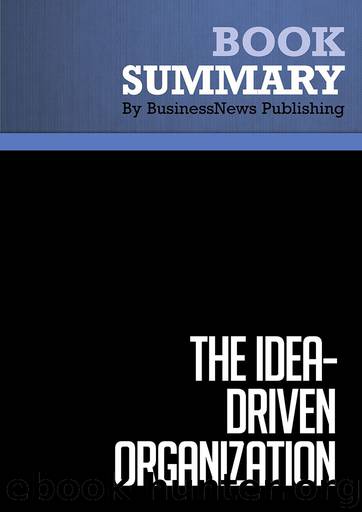The Idea-Driven Organization by BusinessNews Publishing

Author:BusinessNews Publishing
Language: fra
Format: epub
Publisher: FichesdeLecture.com
Published: 2015-03-15T00:00:00+00:00
The stark reality is any policies which directly or indirectly impede the flow of ideas from the front lines need to be modified or eliminated entirely before you can become an idea-driven organization. This can be challenging but it must be done. Train your managers on how to make good policies so they can make new ones which increase the flow of ideas.
Procedures
There has been a long running debate in management thinking about whether it's better to mandate standardized procedures from above or let them be developed (and therefore owned) by the people to whom they apply. Early management guru Frederick Taylor favored management writing the procedures whereas Frank Gilbreth championed the idea that procedures work best when developed by those who do the work.
Idea-driven organizations settle this question by using both approaches. They have the people who do the work document what they're doing and then have the management review those procedures to ensure they comply with necessary standards. In this way, a good foundation for future improvements is created.
Ideally, you want the policies and procedures you adopt to embody all your accumulated knowledge to date. This is why they need to be flexible – as new and better data comes to hand, you want to be able to modify and upgrade your procedures. The faster you can do this to integrate new technologies and new know-how, the better.
In traditional companies, procedures tend to be owned by managers. That means they can only evolve as managers commit the time required to improve them. In idea-driven organizations, all policies and procedures are owned by the people who use them. They are a moving target and can be updated and enhanced frequently.
“Unfortunately, shifting ownership of processes and procedures to the front lines is more than a matter of simply deciding to trust employees and then dumping the responsibility on them. It requires careful goal alignment, well-defined responsibilities and authorities, systematic accountability, and systems to assure that front-line people have the proper skills and information. To us, the common lack of consideration for these elements explains why so many organizational empowerment initiatives experience false starts and failures.”
- Alan Robinson and Dean Schroeder
Download
This site does not store any files on its server. We only index and link to content provided by other sites. Please contact the content providers to delete copyright contents if any and email us, we'll remove relevant links or contents immediately.
Tools of Titans by Timothy Ferriss(8211)
Change Your Questions, Change Your Life by Marilee Adams(7630)
Deep Work by Cal Newport(6873)
Man-made Catastrophes and Risk Information Concealment by Dmitry Chernov & Didier Sornette(5920)
Playing to Win_ How Strategy Really Works by A.G. Lafley & Roger L. Martin(5909)
Digital Minimalism by Cal Newport;(5661)
Big Magic: Creative Living Beyond Fear by Elizabeth Gilbert(5609)
The Slight Edge by Jeff Olson(5345)
Ego Is the Enemy by Ryan Holiday(5292)
The Motivation Myth by Jeff Haden(5154)
Stone's Rules by Roger Stone(5026)
The Laws of Human Nature by Robert Greene(4995)
Tuesdays with Morrie by Mitch Albom(4683)
Eat That Frog! by Brian Tracy(4430)
Rising Strong by Brene Brown(4377)
Skin in the Game by Nassim Nicholas Taleb(4161)
Bullshit Jobs by David Graeber(4091)
The Money Culture by Michael Lewis(4072)
Skin in the Game: Hidden Asymmetries in Daily Life by Nassim Nicholas Taleb(3929)
